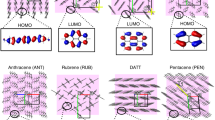Abstract
Semiconductors with mobile donors and acceptors are mixed-ionic-electronic-conductors, MIECs, which exhibit peculiar electronic (electron/hole), I e , current-voltage relations. This is a result of the redistribution of the ions under the applied electrical potential. MIECs are usually ionic materials which exhibit relative low electron/hole mobilities as compared to the materials used in the semiconductor industry. However, thin layers of MIECs exhibit a low resistance and fast response and become of increasing interest.
The I e −V relations are discussed for a few typical examples. It is shown that they depend on the energy band gap as when it is large, the semiconductor is either p-type or n-type. The I e −V relations depend also on the nature of the electrodes, whether blocking for ion exchange or not. Experimental results for Cu2O are presented and analyzed using one of the models discussed.
Similar content being viewed by others
References
I. Riess, Solid State Ionics, 69, 43 (1994).
I. Riess, J. Phys. Chem. Solids, 47, 129 (1986).
F.A. Kröger and H.J. Vink, Solid State Physics, 3, 307 (1956).
E.M. Pell, J. Appl. Phys., 31, 291 (1960).
Y. Tsur and I. Riess, Phys. Rev., B 60, 8138 (1999).
I. Riess, Solid State Ionics, 136–137, 1119 (2000).
G. Yu, Q. Pei, and A.J. Heeger, Appl. Phys. Lett., 70, 934 (1997).
O. Porat and I. Riess, Solid State Ionics, 81, 29 (1995).
Z. Rosenstock, I. Feldman, Y. Gil, and I. Riess, J. Electroceram., 14, 205 (2005).
O. Porat, I. Riess, and H.L. Tuller, Physica C, 192, 60 (1992).
I. Riess, CRC Handbook of Solis State Electrochemistry, edited by P.J. Gellings and H.J.M. Boumeester (CRC Press, Inc. 1997) p. 223.
Z. Rosenstock and I. Riess, Solid State Ionics, 136–137, 921 (2000).
I. Riess, Phys. Rev., B35, 5740 (1987).
M.H. Hebb, J. Chem. Phys., 20, 185 (1952).
C. Wagner, Z. Elektrochem., 60, 4 (1960).
I. Riess and D. Cahen, J. Appl. Phys., 82, 3147 (1997).
Z. Rosenstock, I. Feldman, and I. Riess, Solid State Ionics, 175, 375 (2004).
I. Riess, Z. Phys. Chem., 219, 1 (2005).
Author information
Authors and Affiliations
Corresponding author
Additional information
ICE-2005, KIST, Seoul, Korea, (Invited)
Rights and permissions
About this article
Cite this article
Riess, I. I−V relations in semiconductors with ionic motion. J Electroceram 17, 247–253 (2006). https://doi.org/10.1007/s10832-006-5548-5
Received:
Revised:
Accepted:
Issue Date:
DOI: https://doi.org/10.1007/s10832-006-5548-5




